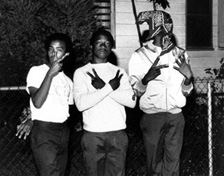United States: The Crips
The Crips, of Los Angeles, are one of the oldest, largest, and most notorious street gangs in the United States.
The gang was founded in 1969 when a teenager named Raymond Washington left a gang called the Avenues to form a new gang called the Baby Avenues, or Avenue Cribs (“crib” referring to the youthfulness of its members). By 1969, the influence of the Black Panthers and other black political groups was waning and Washington supposedly conceived his gang as an organization that would fill the leadership void. The group adopted the Panthers’ trademark black leather jackets, wore earrings in their left lobes, and often walked with canes. When a local newspaper noted the canes and referred to the group as the Crips, as in “cripples,” the name stuck.
The Crips were ultimately never able to develop a social or political platform, and instead became preoccupied with protecting themselves from other neighborhood toughs. As guns began to flow into Los Angeles in the mid-1970s, the Crips’ turf battles became increasingly violent. Raymond Washington apparently advocated against the use of guns, but other members — for instance, Stanley “Tookie” Williams (who was executed by the state of California on December 13, 2005 for four 1979 murders) — resorted to guns anyway.
As the Crips grew larger and increasingly turf-hungry, an alliance formed among several other L.A. street gangs. This was the beginning of the Crips’ rival gang, the Bloods. Both gangs are predominantly African American, and each surged in membership between 1978 and 1982, when deindustrialization led to 70,000 workers being laid off in South Los Angeles, many of them black.
The Crips are known for wearing the color blue, in particular blue bandanas, whereas the Bloods are associated with the color red, and red bandanas. During the 1980s, both gangs became involved in the trade of crack cocaine, an especially lucrative and violent enterprise. Neither the Crips nor the Bloods is a centrally organized syndicate like the Mafia; each name functions more like an umbrella that encloses numerous individual, self-interested gangs. According to retired Los Angeles Deputy Sheriff Wes McBride, the Crips actually kill each other at three times the rate they kill rival members of the Bloods. Still, in 2004, a peace treaty was brokered between the two gangs by former Crips member Stanley “Tookie” Williams, called the “Tookie Protocol for Peace.”

